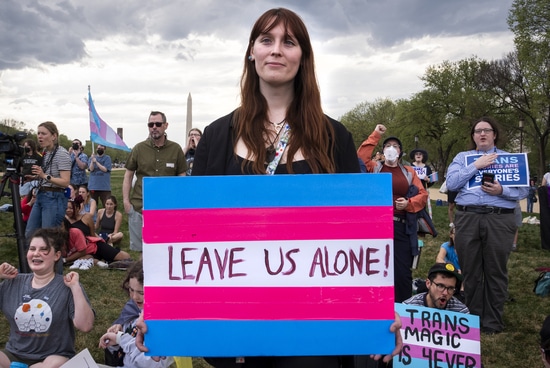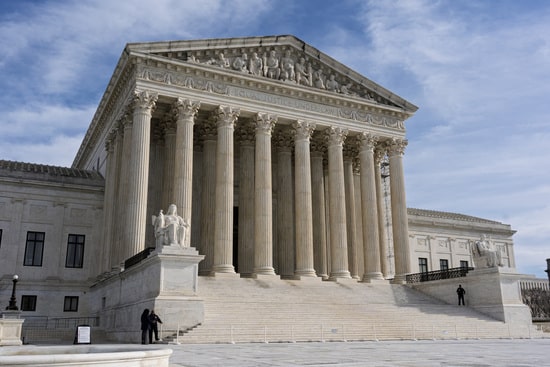Supreme Court steps in to do Trump yet another favor
On Monday, the conservatives on the Supreme Court did President Donald Trump a solid without breaking a sweat … or even the one-page mark. With no explanation, the court let Trump go ahead, at least temporarily, with his bigoted plan to ban transgender people from serving in the military, including forcibly discharging current trans personnel.
By now, it’s almost routine. The administration keeps losing at the lower courts, so they rush to the friendlier confines of the Supreme Court to try to eke out a temporary win, one where Trump gets his way while litigation continues. It’s not a strategy that pans out all the time, but when it does, it’s a treat for Trump and terrible for the rest of us.
And that’s precisely what happened here.
One of Trump’s first executive orders in his new administration was a regurgitation of his first-term attempt to ban transgender service members. The administration said the new ban was necessary for “troop readiness” and that the military was “afflicted with radical gender ideology.”
This was their genius idea to sidestep assertions that this was a ban based on people being trans. No, no, it’s just that trans people happen to be afflicted with radical gender ideology that harms troop readiness. However, the administration didn’t bother to explain how having transgender service members affects troop readiness, save for Trump and his allies just being weird bigots about the existence of trans people.

Things did not go well when two lawsuits over the ban hit the lower courts. In one case, U.S. District Judge Ana Reyes told the administration she would not be “gaslit” by its argument that this ban was somehow not a ban, particularly since Defense Secretary Pete Hegseth called it a ban on X. Oh, and also, Reyes wasn’t happy that nearly every study the administration cited in support of the ban was actually contradicted by those studies.
That’s only one case where the administration got walloped over the ban, with Reyes granting a preliminary injunction that barred the administration from implementing the ban. In another case in federal district court in Washington state, the judge granted a nationwide preliminary injunction, stopping the ban from taking effect while the court case proceeds. U.S. District Judge Benjamin Settle said, “the government’s unrelenting reliance on deference to military judgment is unjustified in the absence of any evidence supporting ‘the military’s’ new judgment[.]”
Fam, is it good when a judge calls you out for mischaracterizing the evidence you’re relying upon, or just straight up points out you don’t have any evidence? No, no, it is not.
These preliminary injunctions against the ban are just that—preliminary. They aren’t final rulings, and all the underlying litigation still continues. In other words, even though the lower courts walloped the administration, it’s only a temporary setback. The administration still gets to fully litigate the ban—full trial, an appeal, the works. But that’s not enough for the administration. They want the ban in place now while figuring out their justification for it.
In general, conservatives are very unhappy about preliminary nationwide injunctions, seeing it as inherently unfair that a judge would ever rule against Trump. But courts don’t hand out preliminary injunctions willy-nilly. Reyes’ order, for example, is 79 pages long and was issued only after the judge heard multiple motions from both sides, both sides filed memoranda and exhibits supporting their position, and the judge held multiple hearings.
It’s the same in the case before Settle. The order granting the preliminary injunction is 65 pages long. There were multiple hearings, and both sides submitted declarations, exhibits, and legal arguments supporting their positions. The order also provides a lengthy legal analysis of the standards for a preliminary injunction.
Parties have to show three things to get a preliminary injunction. First, they must show they’re likely to win at trial. Next, they must prove that the balance of hardships weighs in their favor. Finally, they need to show that their position is the status quo and that it is in the public interest to maintain it.
Settle found that the plaintiffs would likely succeed in showing that the ban was unconstitutional because it violates their right to equal protection and that the ban discriminated against them based on their status.
Next, he found the service members would be harmed by losing their careers, incomes, and reputations. Even if the ban were ultimately overturned and they were eventually reinstated, that harm wouldn’t be undone. In contrast, the harm to the administration is that they have to wait a little longer to be bigots.
Finally, the judge found that the plaintiffs’ position is the status quo. Right now, transgender people can serve in the military. That’s the existing policy. Trump’s ban reverses it.

Overall, the administration’s only support for the ban is demanding the court defer to the military’s decision, even if it doesn’t provide meaningful justification for that decision.
After this loss, the administration went to the 9th U.S. Circuit Court of Appeals, asking it to stay the injunction so the ban could go into effect ASAP. The appeals court disagreed, leading to the administration running to the Supreme Court.
Did the Supreme Court consider any of these things when granting the administration’s request that the preliminary injunction be stayed? We’ll never know! The one-page order does not explain its rationale, though we do learn that the court’s three liberal members would not have granted the stay. So, despite being told by two lower courts that they had presented no real reason for the ban, the administration got its ban anyway.
It’s a way of letting conservative policies go into effect without having to justify anything.
This isn’t a new tactic for the administration. During Trump’s first term, his administration routinely went to the Supreme Court to demand emergency relief, often trying to bypass lower courts. Right now, the administration has five more requests for stays before the court, and the court has already addressed the administration’s stay requests in over half a dozen other cases.
The Supreme Court’s conservatives broadly support Trump and his policies, and the administration knows it. That’s why they can afford to make shoddy, disingenuous arguments to the lower court.
Why not take a big swing when you can largely count on your pals to do your bidding? These requests for emergency relief allow the administration to get a favorable ruling even when its actions fly in the face of existing law. That’s because the conservative justices care as little about procedure as they do about precedent.
Lower courts will keep ruling against Trump because the administration is defying laws, regulations, and the Constitution. Too bad that for at least five people on the Supreme Court, that’s a feature, not a bug.
